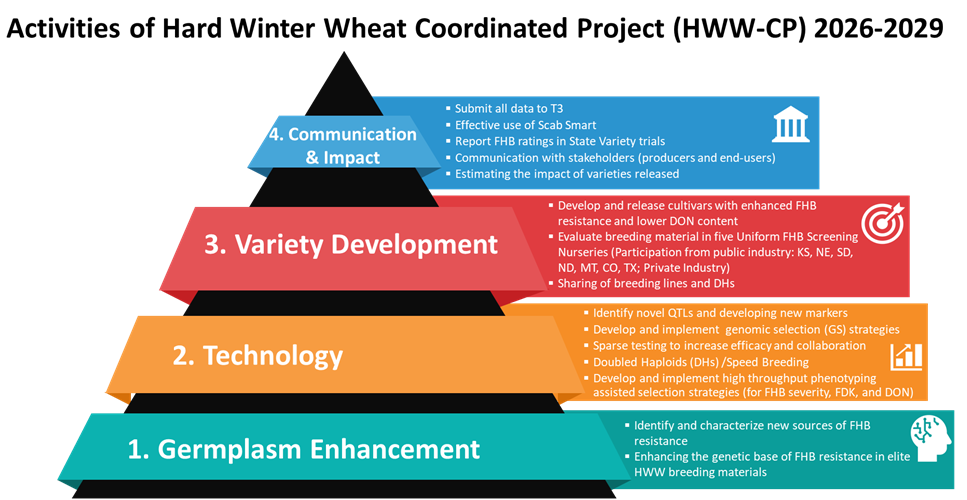Research HWW-CP
Hard Winter Wheat Coordinated Project (HWW-CP)
| Hard Winter Wheat Coordinated Project Committee Members as of: 3/17/25 |
| Chair, Sunish Seghal, South Dakota State University, Brookings, SD |
| Vice Chair, Sue Mondal, Montana State University, Bozeman, MT |
| Shaukat Ali, South Dakota State University, Brookings, SD |
| Narinder Singh, Bayer, St. Louis, MO |
The Hard Winter Wheat Coordinated Project (HWW-CP) is a well-structured initiative aimed at reducing deoxynivalenol (DON) levels in hard winter wheat (HWW) grain to meet the food-grade standards of the European Union (EU), which are stricter than current U.S. regulations. Since approximately half of the HWW produced in the U.S. is exported, there is significant risk that grain from high-scab areas will compromise quality. The HWW-CP is focused on rapidly developing tools and strategies (including breeding and management practices) to lower DON levels in the HWW grain supply. The coordinated project’s research is centered on the following activities 1) development of breeding germplasm with a broader foundation of Fusarium head blight (FHB) resistance; 2) application of emerging tools to map and track FHB resistance, increase selection efficiency and accuracy (using genomic, phenomic, and high-throughput methods), and shorten the breeding cycle through use of doubled haploid/speed breeding and improved parent selection; 3) collaborative evaluation through regional uniform FHB nurseries and release of new varieties with enhanced FHB resistance, reduced DON levels, improved agronomic performance, and superior end-use quality; 4) share the knowledge and germplasm generated; educate and communicate the stakeholders (e.g. producers, the KS, NE, SD, ND, TX, CO, OK, and MT Wheat Commissions, and milling and baking industry) about the efforts, outcomes and impacts of the HWW coordinated project. Further details on HWW-CP activities are illustrated in the figure below. The project is aligned with the goals outlined in the VDHR and MGMT sections of the U.S. Wheat and Barley Scab Initiative USWBSI Action Plan.

| Summary of Funding | ||
| FY24 (2024-25) | FY25 (2025-26) | |
| Number of Projects: | 12 | 12 |
| Number of PIs: | 11 | 11 |
| Total Award Amount: | $753,868 | $761,421* |
| % of Total Funding: | 9.85% | 9.95% |
| Research Projects: | FY24 | FY25 |
*Received Equipment Request Funding
Research Reports/Publications
Workshop/Planning Meeting Reports
- Report: 2021 USWBSI Hard Winter Wheat CP Planning Meeting Posted: 6/14/21
- Report: 2017 USWBSI Hard Winter Wheat CP Planning Meeting
- Report: 2015 USWBSI Hard Winter Wheat CP Planning Meeting
- Report: 2011 USWBSI Hard Winter Wheat CP Planning Meeting
- Report: 2009 USWBSI Hard Winter Wheat CP Planning Meeting
- Report from 4-08 HWW-CP Planning Meeting
Hard Winter Wheat Nursery Reports/Updates Reports posted for past 5 years, prior reports available in the USWBSI Documents Database.
- Reaction of Selected Winter Wheat Cultivars in Kansas to Fusarium Head Blight (FHB), 2024. Posted: 06/23/25
- Disease Severity of Selected Southern Wheat Cultivars to Fusarium Head Blight (FHB), 2023.
- Reaction of Selected Winter Wheat Cultivars to Fusarium Head Blight (FHB), 2023.
- Disease Severity of Selected Northern Wheat Cultivars to Fusarium Head Blight (FHB), 2023.
- Reaction of Selected Winter Wheat Cultivars in Kansas to Fusarium Head Blight (FHB), 2023.
- Reaction of Selected Winter Wheat Cultivars in Kansas to Fusarium Head Blight (FHB), 2022.
- Disease Severity of Selected Winter Wheat Cultivars to Fusarium Head Blight (FHB), 2022.
- Reaction of Kansas Interstate Nursery winter wheat accessions to Fusarium head blight, 2021.
- Reaction of Winter Wheat Accessions to Fusarium Head Blight, 2020 - Northern (ND, MT, and SD), Central (CO, KS, and NE)and Southern (OK and TX)
- Reaction of selected winter wheat accessions to Fusarium head blight (FHB), 2020.
- Reaction of Kansas Interstate Nursery winter wheat accessions to Fusarium head blight, 2020.
- Evaluation of foliar fungicides for control of Fusarium head blight, 2020.
Publications
